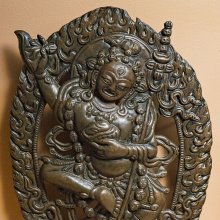Guhyeshvari, Guhyeśvarī, Guhya-ishvari: 6 definitions
Introduction:
Guhyeshvari means something in Buddhism, Pali, Hinduism, Sanskrit, the history of ancient India. If you want to know the exact meaning, history, etymology or English translation of this term then check out the descriptions on this page. Add your comment or reference to a book if you want to contribute to this summary article.
The Sanskrit term Guhyeśvarī can be transliterated into English as Guhyesvari or Guhyeshvari, using the IAST transliteration scheme (?).
Images (photo gallery)
In Hinduism
Shaktism (Shakta philosophy)
Source: Google Books: ManthanabhairavatantramGuhyeśvarī (गुह्येश्वरी) is the Goddess associated with Uttarāmnāya (one of the six āmnāyas), according to Mukundarāja’s Saṃvartārthaprakāśa.—[...] Only the northern, western and upper āmnāyas are extensively functional amongst the Newars, in theory, like other Kaulas, they follow a system of six āmnāyas. This is largely based on the Parātantra. Thus, those listed in the Saṃvartārthaprakāśa by Mukundarāja, who was a Newar, agree with that source. The goddesses in the six āmnāyas are: [e.g., North: Uttarāmnāya—Guhyeśvarī]. [...]

Shakta (शाक्त, śākta) or Shaktism (śāktism) represents a tradition of Hinduism where the Goddess (Devi) is revered and worshipped. Shakta literature includes a range of scriptures, including various Agamas and Tantras, although its roots may be traced back to the Vedas.
In Buddhism
Tibetan Buddhism (Vajrayana or tantric Buddhism)
Source: OSU Press: Cakrasamvara SamadhiGuhyeśvarī (गुह्येश्वरी) or “Śrī Guyeśvarī Prajñāpāramita” is the name of a deity, according to the Guru Mandala Worship (maṇḍalārcana) ritual often performed in combination with the Cakrasaṃvara Samādhi, which refers to the primary pūjā and sādhanā practice of Newah Mahāyāna-Vajrayāna Buddhists in Nepal.—Accordingly, “[...] On the Bharata continent, in northern Pāñcāla, at the feet of the Himalayas, In the land of Vāsuki, the seat of Upachandoha, in the holy land Āryāvarta, In the home of Karkoṭaka king of serpents, In the great lake Nāgavāsa, Site of Śrī Svayambhū Caitya, inhabited by Śrī Guyeśvarī Prajñāpāramita, In the land of the Nepal mandala, in the form of the Śrī Saṃvara mandala, In the same land of Sudurjayā, [...]”.,

Tibetan Buddhism includes schools such as Nyingma, Kadampa, Kagyu and Gelug. Their primary canon of literature is divided in two broad categories: The Kangyur, which consists of Buddha’s words, and the Tengyur, which includes commentaries from various sources. Esotericism and tantra techniques (vajrayāna) are collected indepently.
India history and geography
Source: academia.edu: Elements of Newar Buddhist ArtGuhyeśvarī (गुह्येश्वरी) represents the main deity of Waterholes according to both Hindus and Buddhists.—The Svayambhu-Purana prescribes worshiping the waterholes (jalotpanna-randhrani) on the full moon day of Sravana month, when the copious monsoon rain is expected. The waterholes are believed to be the reminiscent of the primordial lake of the Kathmandu valley. Both Hindus and Buddhists agree that the main deity of the waterholes is Guhyesvari, and worship her as their tutelary lineage deities, variously called istadevata, kuladevata or degudya. However, the Newar Buddhist tradition of the (Kathmandu) valley prefers to identify her with the dharmodaya triangle. This is evidenced by a brief statement found in the Svayambhu-Purana, where the symbolic representation of this goddess is described as a yoni like dharmodaya.

The history of India traces the identification of countries, villages, towns and other regions of India, as well as mythology, zoology, royal dynasties, rulers, tribes, local festivities and traditions and regional languages. Ancient India enjoyed religious freedom and encourages the path of Dharma, a concept common to Buddhism, Hinduism, and Jainism.
Languages of India and abroad
Sanskrit dictionary
Source: Cologne Digital Sanskrit Dictionaries: Monier-Williams Sanskrit-English DictionaryGuhyeśvarī (गुह्येश्वरी):—[from guhya > guh] f. ‘mystic deity’ id est. Prajñā (female energy of the Ādi-buddha), [SvayambhūP.]
[Sanskrit to German]
Sanskrit, also spelled संस्कृतम् (saṃskṛtam), is an ancient language of India commonly seen as the grandmother of the Indo-European language family (even English!). Closely allied with Prakrit and Pali, Sanskrit is more exhaustive in both grammar and terms and has the most extensive collection of literature in the world, greatly surpassing its sister-languages Greek and Latin.
See also (Relevant definitions)
Partial matches: Ishvari, Guhya.
Starts with: Guhyeshvaritirtha.
Full-text: Khaganana, Guhyeshvara, Hmasinga, Dharmodaya, Guhyeshvaritirtha, Waterhole, Dharmadhatu.
Relevant text
Search found 1 books and stories containing Guhyeshvari, Guhyeśvarī, Guhya-ishvari, Guhyesvari, Guhya-īśvarī, Guhya-isvari; (plurals include: Guhyeshvaris, Guhyeśvarīs, ishvaris, Guhyesvaris, īśvarīs, isvaris). You can also click to the full overview containing English textual excerpts. Below are direct links for the most relevant articles:
Varahi Tantra (English Study) (by Roberta Pamio)
